Temperature-Dependent Model of Rutting Behavior for Connected Layer Mixtures in Flexible Base Asphalt Pavement
Abstract
:1. Introduction
2. Materials and Methods
2.1. Materials
2.1.1. Asphalt
2.1.2. Aggregate
- (1)
- Coarse Aggregate
- (2)
- Fine aggregate
- (3)
- Mineral powder
- (4)
- Asphalt mixtures
2.2. Methods
2.2.1. Sample Preparation Method
- (1)
- The Lower Plate
- (2)
- Sticky Layer Oil
- (3)
- The Upper Plate
2.2.2. Service Behavior of Connecting Layer—Temperature-Dependent Model
- (1)
- According to Section 2.2.1, double-layer rutting plate samples were prepared using various types of asphalt binders. This study selected four types of asphalt binders: 70#, 50#, and 30# base asphalt binders, as well as SBS-modified asphalt binder.
- (2)
- The double-layer samples were placed in a drying oven at the target temperature for 6–8 h. To encompass a range of typical temperatures while also considering extreme conditions, this study identified six temperature levels: 10 °C, 15 °C, 20 °C, 30 °C, 45 °C, and 60 °C.
- (3)
- According to the method T0719-2011 in “Standard Test Methods of Bitumen and Bituminous Mixtures in Highway Engineering (JTG E20-2011)” [34], an automatic asphalt mixture rutting tester was developed for the double-layer rutting plate samples (see Table 7 and Figure 2 for details of the instrument) to measure the rutting depth of these samples. The dynamic stability can be calculated using Equation (1). According to the Chinese specifications “Specifications for Design of Highway Asphalt Pavement (JTG D50-2017)” [35] and “Technical Specification for Construction of Highway Asphalt Pavements (JTG F40-2004)” [36], this study selected four types of loads: 0.5 MPa, 0.7 MPa, 0.9 MPa, and 1.1 MPa. Three samples were successfully tested.
- (4)
- Through the analysis of the laws governing dynamic stability and rutting depth at various temperatures, an appropriate framework was established to elucidate the relationship between rutting behavior (dynamic stability or rutting depth) and temperature. Further details can be found in Section 3.2 and Section 4.2.2.
3. Dynamic Stability (DS): A Temperature-Dependent Model
3.1. Dynamic Stability Test Results
3.2. Dynamic Stability: A Temperature-Dependent Model Research
4. Rutting Deformation (RD): A Temperature- and Load-Dependent Model
4.1. Results of the Rut Deformation Test
- (1)
- With the increase in load times, rutting development curves of different asphalt types are very similar. At the beginning, the rut depth show a linear increase trend, and the increase rate of the rut depth slows down and tends to be stable in the end, which indicates that the rut shape of the connecting layer mixture will approach a limit value (RD∞) with the increase in loading times.
- (2)
- With the increase in temperature, the rutting depth of the mixture of the connecting layer shows an increasing trend, and the rutting depth changes obviously when the temperature is greater than 30 °C.
- (3)
- Compared to the 70# asphalt mixture, the rutting deformation of 30#, 50#, and SBS asphalt mixtures is reduced. For the AC-20 asphalt mixture, the rut depth of 30#, 50#, and SBS asphalt mixtures is reduced by 18%, 33%, and 40% on average compared to the 70# asphalt mixture under standard conditions. For AC-25 asphalt blends, 30#, 50#, and SBS asphalt blends have an average reduction in rut depth of approximately 19%, 34%, and 39% compared to 70# asphalt blends.
4.2. The Temperature- and Load-Dependent Model
4.2.1. Influencing Factors of Rutting Deformation of Asphalt Mixture
- (1)
- Effect of temperature
- (2)
- Effect of load
- (3)
- The effect of the number of actions
4.2.2. Rutting Estimation Model
5. Conclusions
- (1)
- The rutting behavior of the adhesive layer in asphalt pavement was thoroughly investigated. Temperature significantly affected the rutting behavior of the adhesive layer mixture. Specifically, the rutting depth increased with rising temperatures; initially, the rutting depth increased rapidly, before stabilizing under load.
- (2)
- There were differences in rutting deformation among various asphalt types. The rutting deformation of 30#, 50#, and SBS asphalt mixtures was lower compared to that of 70# asphalt mixtures.
- (3)
- The dynamic stability of the mixture decreased with increasing temperature, while it tended to remain stable at both high and low temperatures. As the temperature increased, the rutting depth of the mixture increased. Additionally, with an increase in the number of load applications, the rutting depth at the bonding layer initially increased rapidly before stabilizing.
- (4)
- A correlation model was established based on the test results. The correlation between rutting deformation and the temperature–load dependence model was as high as 97%, while the correlation between dynamic stability and the temperature dependence model reached 99%.
- (5)
- The model established by the research results provides scientific support for the design and optimization of asphalt pavement, which is highly significant. These models can accurately predict rutting deformation and dynamic stability under varying temperatures and load conditions. They provide essential data for pavement structure design, assist in the appropriate selection of asphalt types, and optimize the combination of pavement structures. This ultimately enhances the pavement’s ability to resist rutting and extends its service life.
Author Contributions
Funding
Institutional Review Board Statement
Informed Consent Statement
Data Availability Statement
Conflicts of Interest
References
- Shukla, P.K.; Das, A. A revisit to the development of fatigue and rutting equations used for asphalt pavement design. Int. J. Pavement Eng. 2008, 9, 355–364. [Google Scholar] [CrossRef]
- Faruk AN, M.; Lee, S.I.; Zhang, J.; Naik, B.; Walubita, L.F. Measurement of HMA shear resistance potential in the lab: The Simple Punching Shear Test. Constr. Build. Mater. 2015, 99, 62–72. [Google Scholar] [CrossRef]
- Norouzi, A.; Kim, D.; Richard Kim, Y. Numerical evaluation of pavement design parameters for the fatigue cracking and rutting performance of asphalt pavements. Mater. Struct. 2016, 49, 3619–3634. [Google Scholar] [CrossRef]
- Chun, S.; Kim, K.; Greene, J.; Choubane, B. Evaluation of interlayer bonding condition on structural response characteristics of asphalt pavement using finite element analysis and full-scale field tests. Constr. Build. Mater. 2015, 96, 307–318. [Google Scholar] [CrossRef]
- Al-Jarazi, R.; Rahman, A.; Ai, C.F. A Robust Statistical Analysis of Factors Affecting Interface Bonding between Asphalt Pavement Layers. Key Eng. Mater. 2024, 986, 67–73. [Google Scholar] [CrossRef]
- Xu, J.; Li, N.; Xu, T. Temperature changes of interlaminar bonding layer in different seasons and effects on mechanical properties of asphalt pavement. Int. J. Pavement Res. Technol. 2021, 15, 589–605. [Google Scholar] [CrossRef]
- Knott, J.F.; Sias, J.E.; Dave, E.V.; Jacobs, J.M. Seasonal and long-term changes to pavement life caused by rising temperatures from climate change. Transp. Res. Rec. 2019, 2673, 267–278. [Google Scholar] [CrossRef]
- Qiao, Y.; Dawson, A.R.; Parry, T.; Flintsch, G.; Wang, W. Flexible pavements and climate change: A comprehensive review and implications. Sustainability 2020, 12, 1057. [Google Scholar] [CrossRef]
- Li, L.; Chen, Y.; Jiang, J.Q. Anti-rutting performance pre-control method of dense skeleton type asphalt mixture based on volumetric index and fractal theory. J. Mater. Sci. Eng. 2018, 36, 7. [Google Scholar]
- Deng, C.Q.; Jiang, Y.J.; Lin, H.W.; Chen, Z.J.; Ji, X.P. Influence of gradations on performance of emulsified asphalt cold recycled mixture produced using vertical vibration compaction method. Road Mater. Pavement Des. 2019, 22, 983–1003. [Google Scholar] [CrossRef]
- Xiao, F.P.; Li, R.Y.; Amirkhanian, S.; Yuan, J. Rutting-Resistance Investigation of Alternative Polymerized Asphalt Mixtures. J. Mater. Civ. Eng. 2018, 30, 04018116. [Google Scholar] [CrossRef]
- Tong, Z.F.W. Preparation and evaluation of 30# hard grade asphalt. Pet. Sci. Technol. 2017, 35, 436–442. [Google Scholar]
- Song, L.; Xie, X.; Tu, P.; Fan, J.; Gao, J. Study on aging mechanism and high-temperature rheological properties of low-grade hard asphalt. Materials 2023, 16, 5641. [Google Scholar] [CrossRef] [PubMed]
- Enieb, M.; Shbeeb, L.; Asi, I.; Yang, X.; Diab, A. Effect of Asphalt Grade and Polymer Type (SBS and EE-2) on Produced PMB and Asphalt Concrete Mix Properties. J. Mater. Civ. Eng. 2020, 32, 04020385. [Google Scholar] [CrossRef]
- Zeng, G.D.; Wu, W.J.; Li, J.C.; Xu, Q.S.; Li, X.H.; Yan, X.P.; Han, Y.; Wei, J.C. Comparative Study on Road Performance of Low-Grade Hard Asphalt and Mixture in China and France. Coatings 2022, 12, 270. [Google Scholar] [CrossRef]
- Song, L.; Tu, P.C.; Xie, X.D.; Fan, J.J.; Hou, L.L.; Gao, J. Rheological properties and engineering application of low-grade asphalt mixture. Materia 2023, 28, e20230208. [Google Scholar] [CrossRef]
- Du, Y.; Chen, J.; Han, Z.; Liu, W. A review on solutions for improving rutting resistance of asphalt pavement and test methods. Constr. Build. Mater. 2018, 168, 893–905. [Google Scholar] [CrossRef]
- Wasage TL, J.; Stastna, J.; Zanzotto, L. Comparison of the rutting potential of paving mixes produced from different asphalt binders with the same superpave high-temperature performance. Can. J. Civ. Eng. 2010, 37, 1406–1413. [Google Scholar] [CrossRef]
- Liu, L.; Wang, C.; Zuo, Z.; Yuan, H.; Lu, J.; Chen, Q. Asphalt pavement heat insulation bonding layer materials: Composition optimization and engineering application. J. Clean. Prod. 2024, 449, 141727. [Google Scholar] [CrossRef]
- Liu, L.; Wang, C.; Liang, Q. Preparation of a heat insulation bonding layer for roads and its heat insulation effect. J. Clean. Prod. 2022, 365, 132828. [Google Scholar] [CrossRef]
- Behnke, R.; Kaliske, M.; Schuck, B.; Stein, M.; Alber, S.; Ressel, W.; Wellner, F.; Leischner, S.; Canon Falla, G.; Eckstein, L. From the material behaviour to the thermo-mechanical long-term response of asphalt pavements and the alteration of surface drainage due to rutting: A sensitivity study. Int. J. Pavement Eng. 2023, 24, 2247132. [Google Scholar] [CrossRef]
- Zhao, Y.; Jiang, L.; Zhou, L. Ambient temperature and vehicle loading effects on asphalt concrete pavement rutting development. In Proceedings of the Fifth International Conference on Transportation Engineering, Dalian, China, 26–27 September 2015; pp. 1084–1091. [Google Scholar]
- Alae, M.; Zarei, S.; Ouyang, J.; Xiao, F.P. Prediction of top-down crack resistance in semi-flexible pavements under coupling effect of rutted surface and temperature gradient. Int. J. Pavement Eng. 2022, 24, 1080. [Google Scholar] [CrossRef]
- Si, C.D.; Cao, H.; Chen, E.L.; You, Z.P.; Tian, R.L.; Zhang, R.; Gao, J.F. Dynamic Response Analysis of Rutting Resistance Performance of High Modulus Asphalt Concrete Pavement. Appl. Sci. 2019, 8, 2701. [Google Scholar] [CrossRef]
- Behnke, R.; Wollny, I.; Hartung, F.; Kaliske, M. Thermo-mechanical finite element prediction of the structural long-term response of asphalt pavements subjected to periodic traffic load: Tire-pavement interaction and rutting. Comput. Struct. 2019, 218, 9–31. [Google Scholar] [CrossRef]
- Kim, H.; Arraigada, M.; Raab, C.; Partl, M.N. Numerical and experimental analysis for the interlayer behavior of double-layered asphalt pavement samples. J. Mater. Civ. Eng. 2011, 23, 12–20. [Google Scholar] [CrossRef]
- Mendez Larrain, M.M.; Tarefder, R.A. Weibull model for rutting prediction of warm-mix asphalt agents: Using hamburg wheel-tracking device results. Transp. Res. Rec. 2016, 2575, 206–212. [Google Scholar] [CrossRef]
- Hong, F.; Chen, D.H. Calibrating Mechanistic-Empirical Design Guide permanent deformation models based on accelerated pavement testing. J. Test. Eval. 2009, 37, 31–39. [Google Scholar] [CrossRef]
- Ji, X.; Zheng, N.; Hou, Y.; Niu, S. Application of asphalt mixture shear strength to evaluate pavement rutting with accelerated loading facility (ALF). Constr. Build. Mater. 2013, 41, 1–8. [Google Scholar] [CrossRef]
- Wan, T.; Wang, H.; Yang, X.; Chen, Y.; Li, L.; Diab, A. Thermal contraction coordination behavior between unbound aggregate layer and asphalt mixture overlay based on the finite difference and discrete element coupling method. Comput.-Aided Civ. Infrastruct. Eng. 2024, 39, 2140–2158. [Google Scholar] [CrossRef]
- Zhang, Y.; Luo, D. Analysis of Coupling Effect and Heavy Load of High-Temperature Stability of Asphalt Mixture. Adv. Mater. Sci. Eng. 2022, 2022, 5722752. [Google Scholar]
- Alkaissi, Z.A. Effect of high temperature and traffic loading on rutting performance of flexible pavement. J. King Saud Univ.-Eng. Sci. 2020, 32, 1–4. [Google Scholar] [CrossRef]
- Ji, X.; Zheng, N.; Niu, S.; Meng, S.; Xu, Q. Development of a rutting prediction model for asphalt pavements with the use of an accelerated loading facility. Road Mater. Pavement Des. 2016, 17, 15–31. [Google Scholar] [CrossRef]
- JTG E20-2011; Standard Test Methods of Bitumen and Bituminous Mixtures for Highway Engineering (JTG E20). Ministry of Transport of the People’s Republic of China: Beijing, China, 2011.
- JTG D50-2017; Specifications for Design of Highway Asphalt Pavement (JTG D50). Ministry of Transport of the People’s Republic of China: Beijing, China, 2017.
- JTG F40-2004; Technical Specification for Construction of Highway Asphalt Pavements (JTG F40). Ministry of Transport of the People’s Republic of China: Beijing, China, 2004.
- Li, L.; Guo, E.; Lin, Y.; He, Z. A design method on durable asphalt pavement of flexible base on anti-rutting performance and its application. Materials 2023, 16, 7122. [Google Scholar] [CrossRef] [PubMed]
- Luan, Y.; Ma, Y.; Ma, T.; Wang, C.; Xia, F. Research on the effects of asphalt performance on rutting resistance and its correlation with rutting performance indicators. Constr. Build. Mater. 2023, 400, 132773. [Google Scholar] [CrossRef]
- Pan, Y.; Guo, H.; Guan, W.; Zhao, Y. A laboratory evaluation of factors affecting rutting resistance of asphalt mixtures using wheel tracking test. Case Stud. Constr. Mater. 2023, 18, e02148. [Google Scholar] [CrossRef]
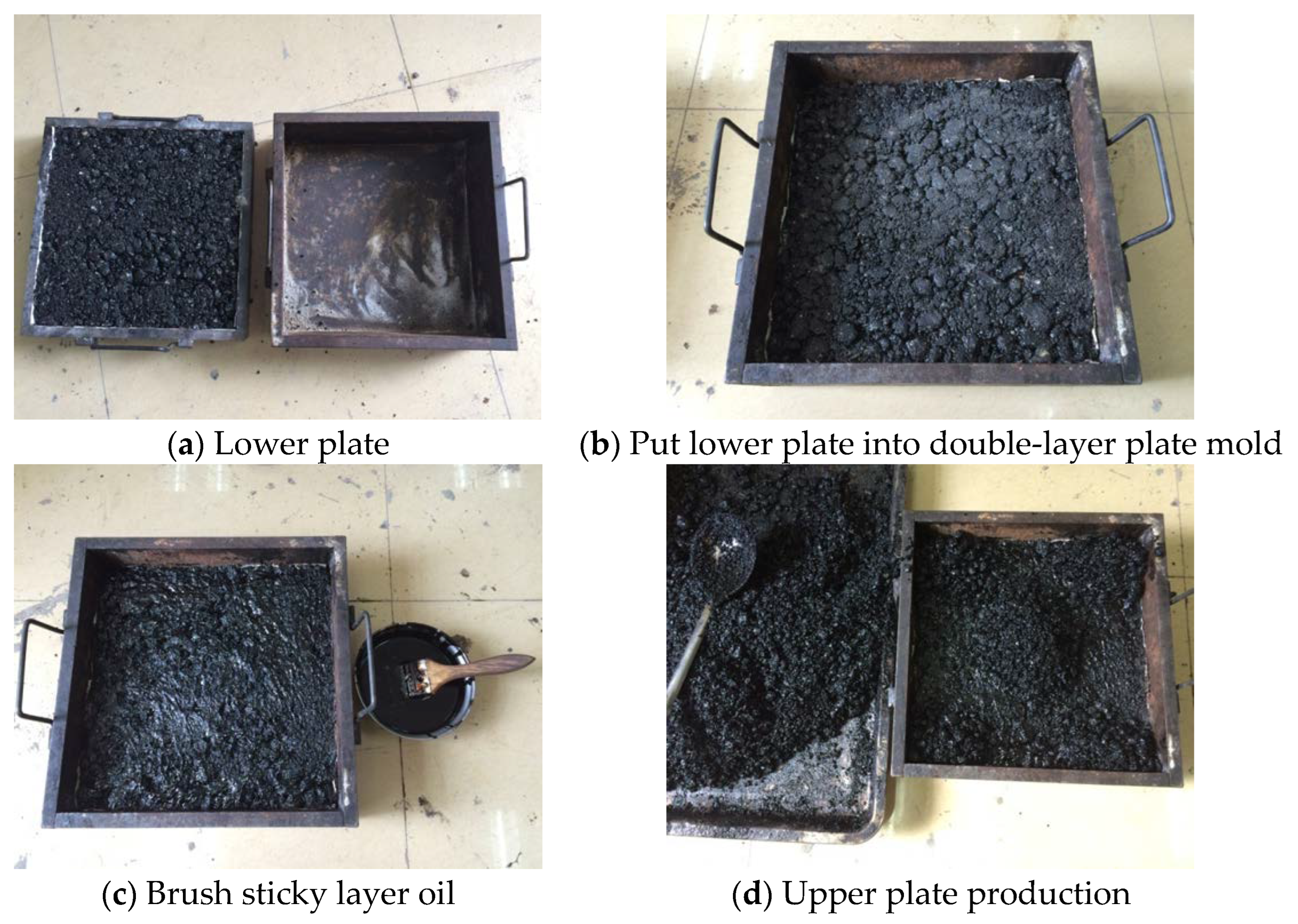

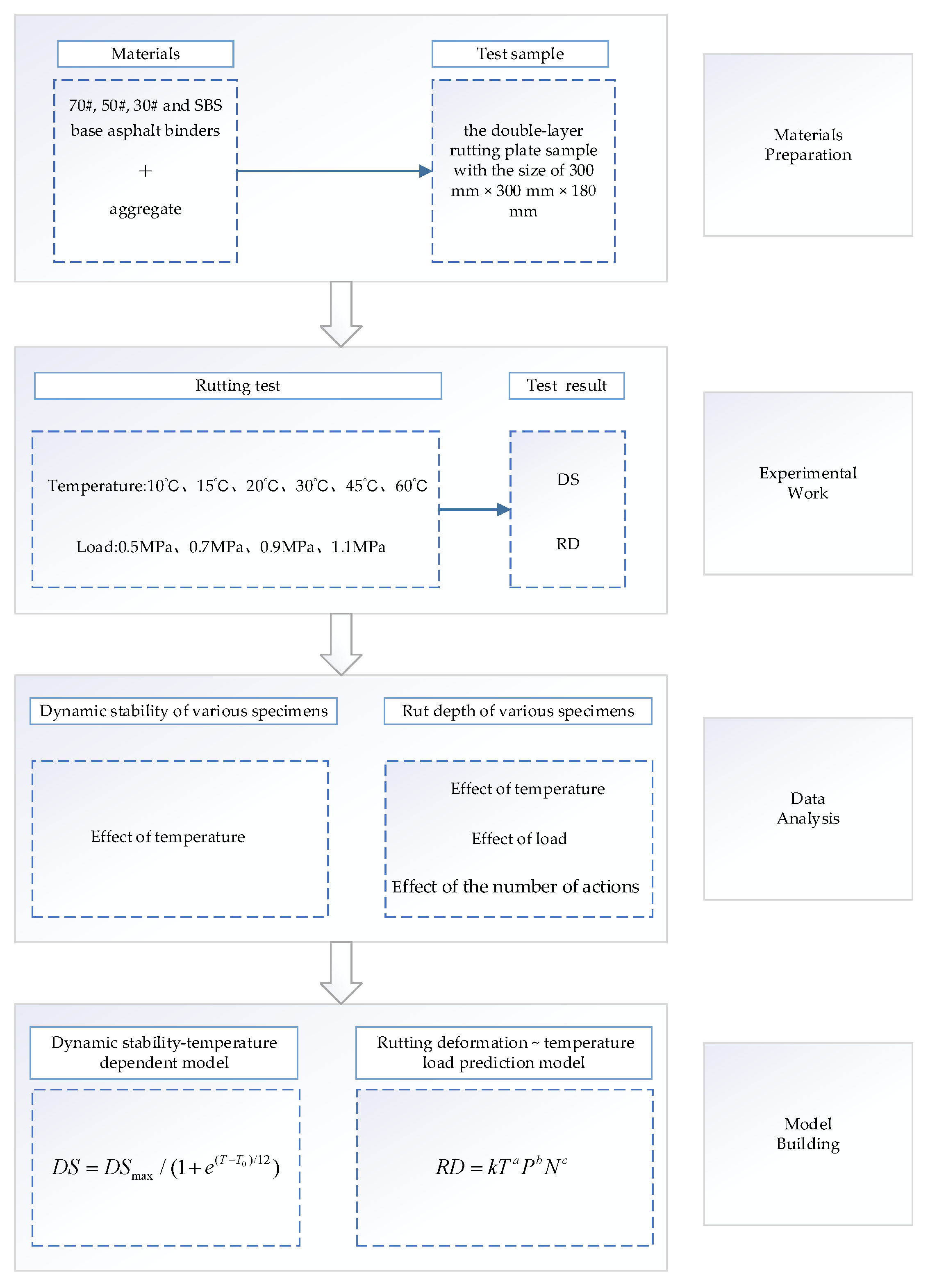
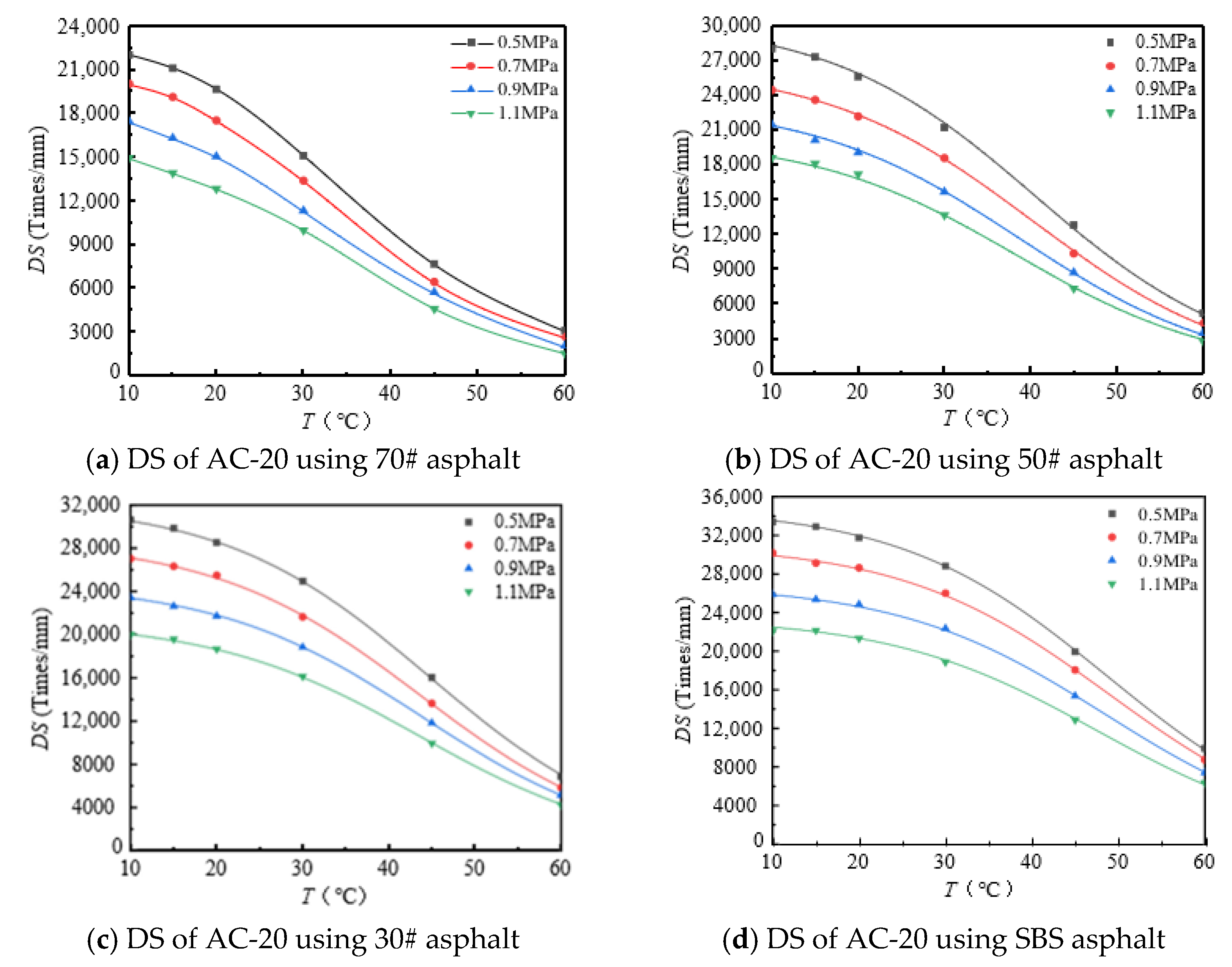
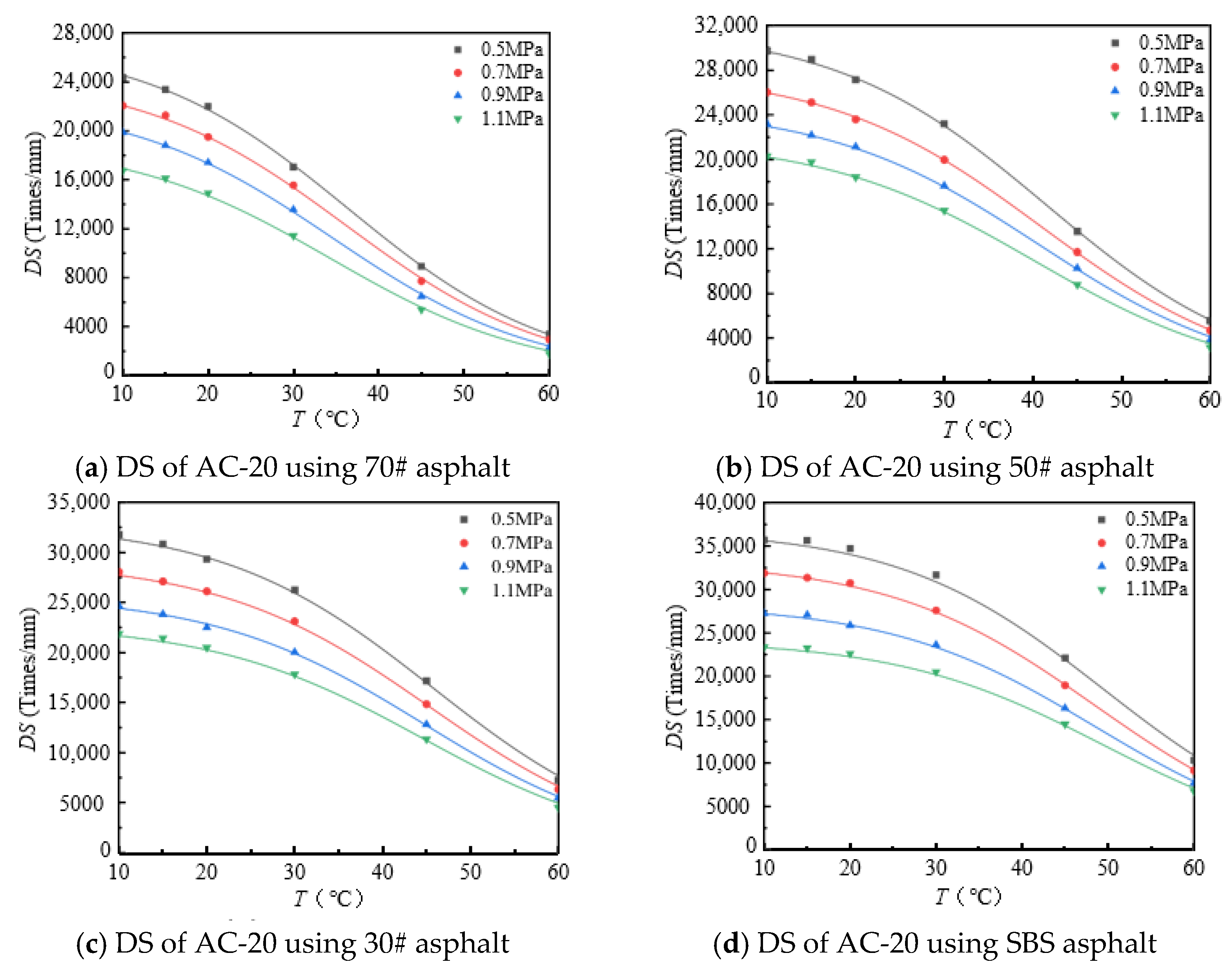




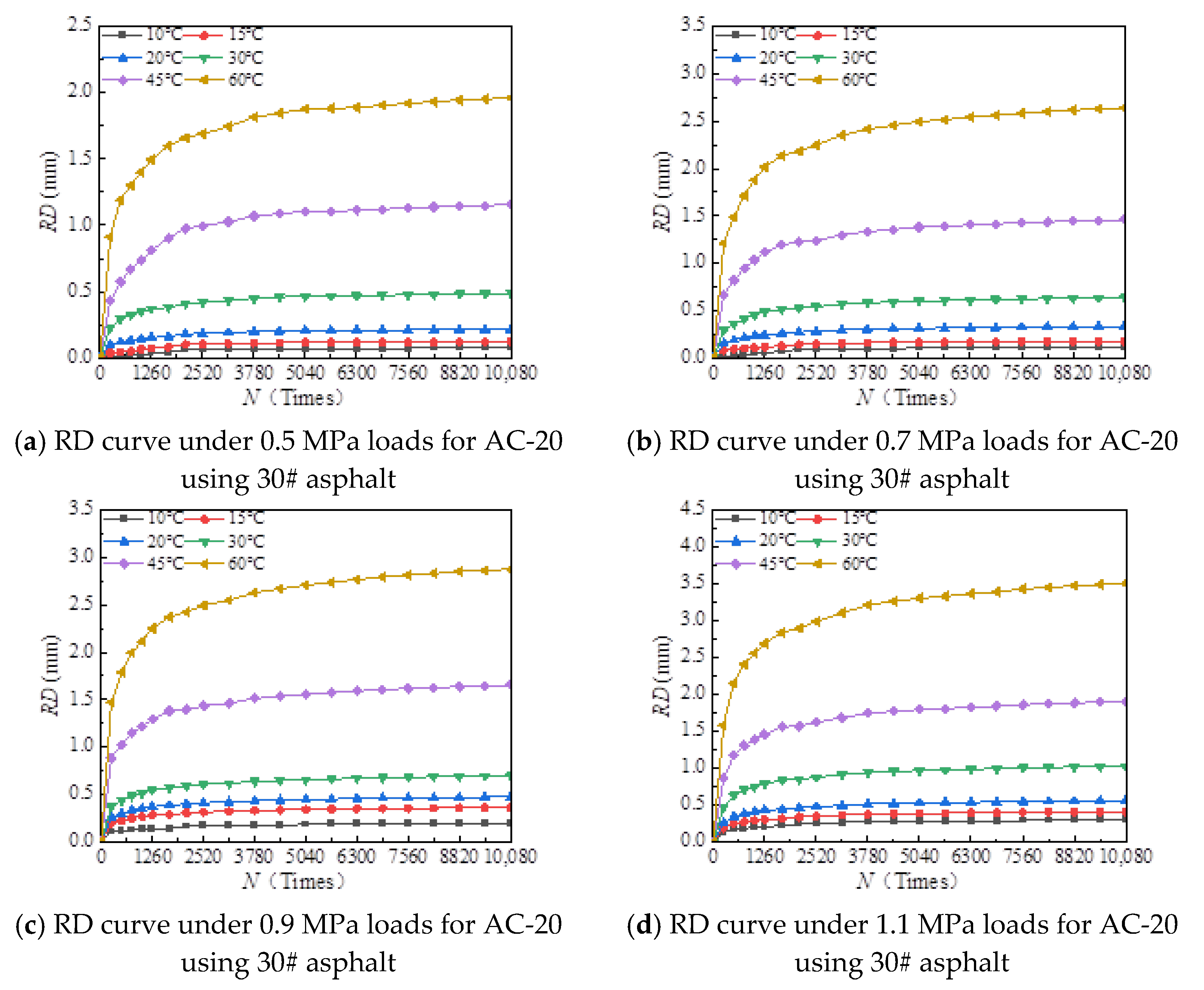
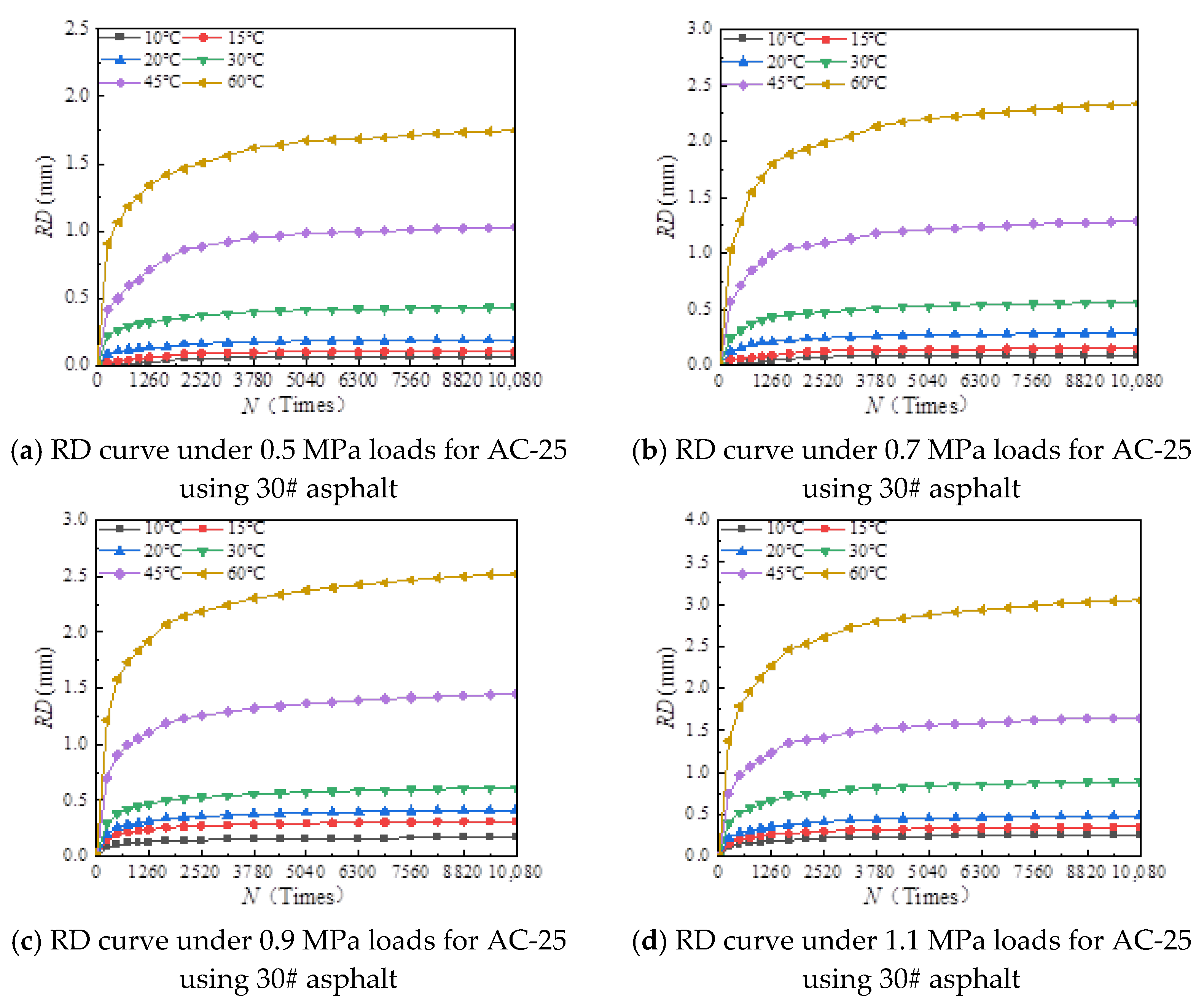
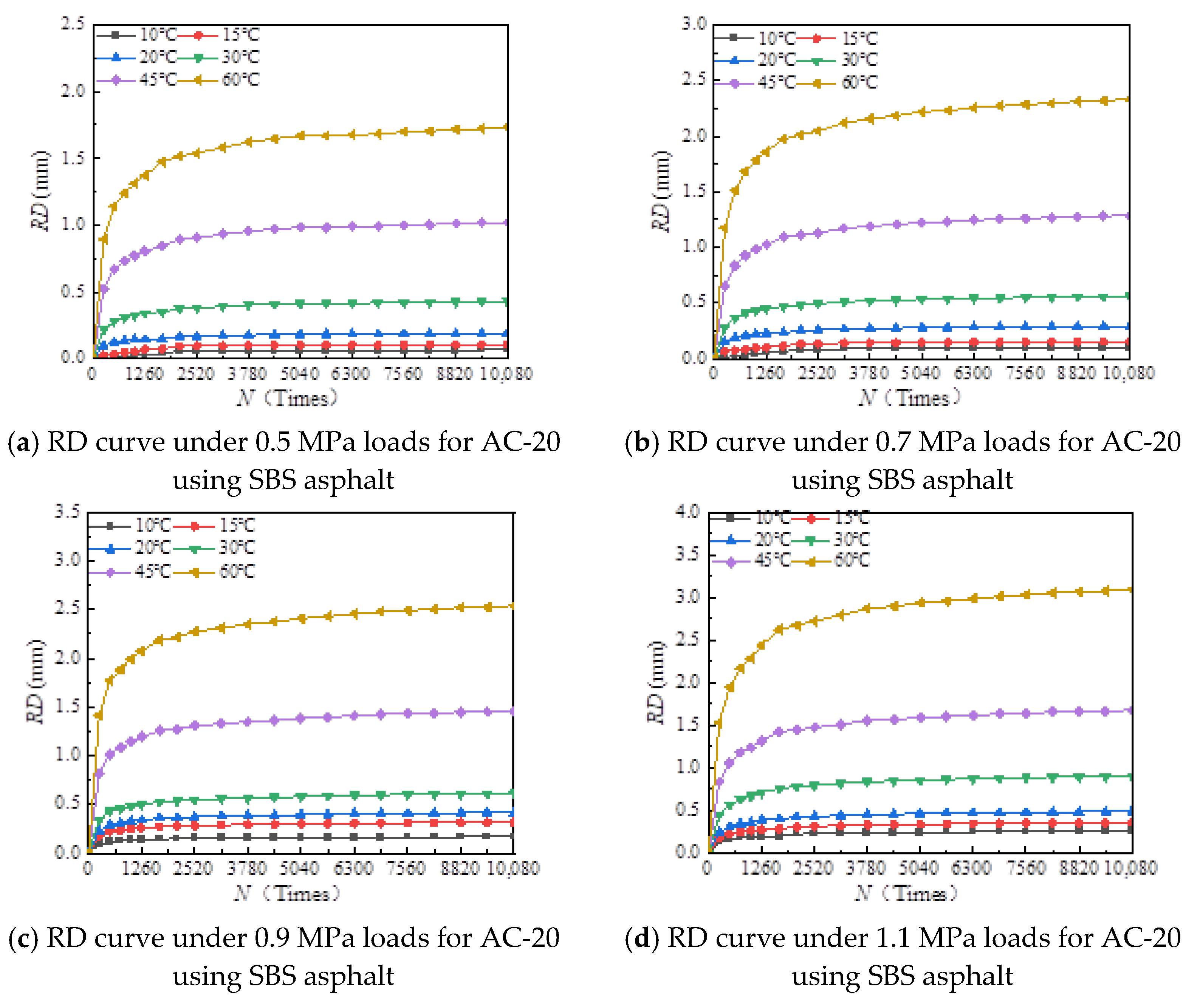

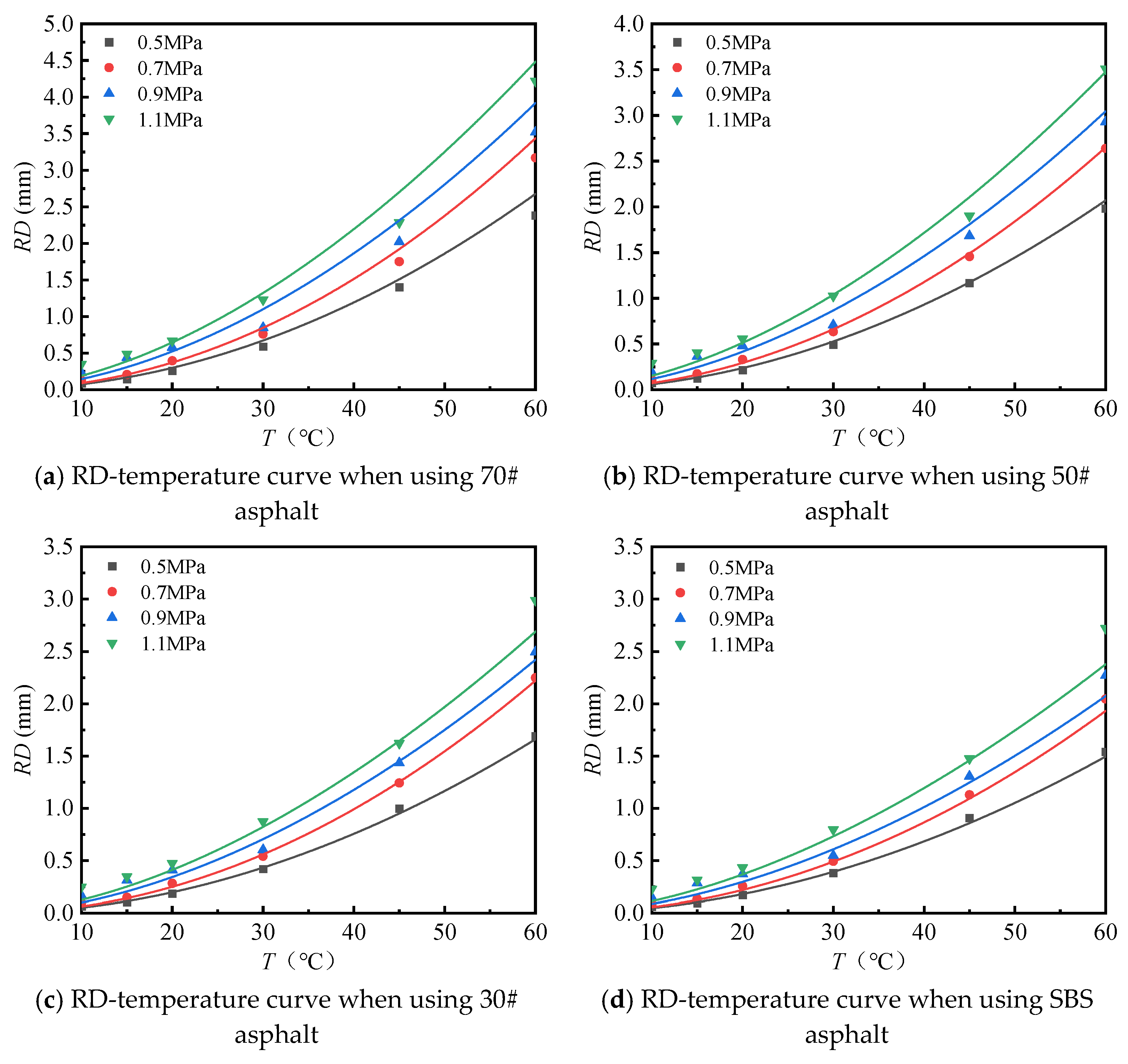
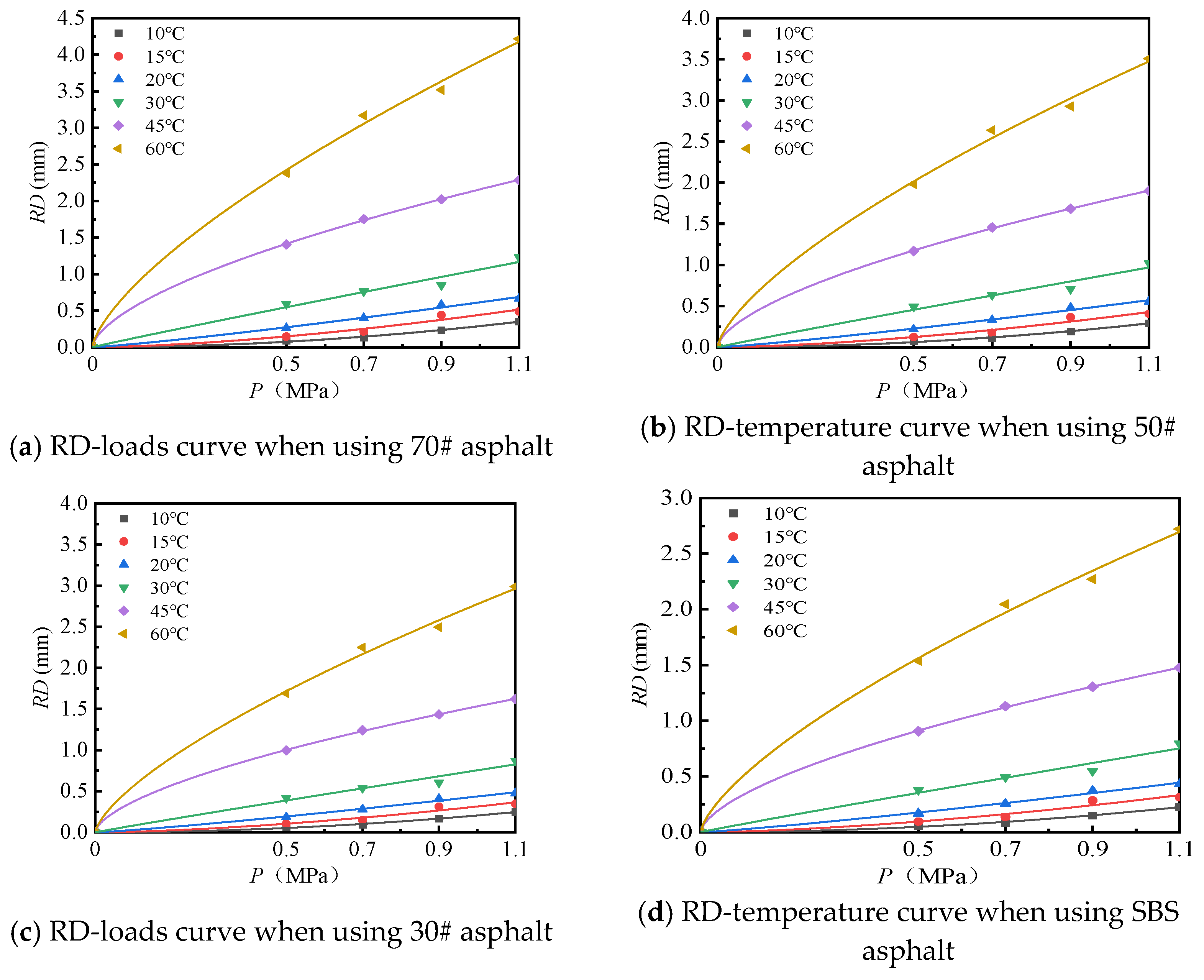

| Index | 70# | 50# | 30# | SBS | |||||
|---|---|---|---|---|---|---|---|---|---|
| Test Value | Standard Value | Test Value | Standard Value | Test Value | Standard Value | Test Value | Standard Value | ||
| Needle penetration (0.1 mm) | 15 °C | 22 | / | 17 | / | 13 | / | 16 | / |
| 25 °C | 69 | 60–80 | 52 | 40–60 | 35 | 20–40 | 47 | 30–60 | |
| 30 °C | 98 | / | 71 | / | 52 | / | 58 | / | |
| PI | −0.654 | −1.5–1.0 | −0.385 | −1.5–1.0 | −0.083 | −1.5–1.0 | 0.239 | ≥0 | |
| Ductility (cm) | 5 °C | / | / | / | / | / | / | 38 | ≥20 |
| 10 °C | 38 | ≥20 | 21 | ≥15 | 12 | ≥ 10 | / | / | |
| 15 °C | >100 | ≥100 | 84 | ≥80 | 54 | ≥ 50 | / | / | |
| Softening point (°C) | 48 | ≥46 | 53 | ≥49 | 59 | ≥ 55 | 75 | ≥60 | |
| Wax content (%) | 0.8 | ≤2.2 | 1.3 | ≤2.2 | 1.5 | ≤ 2.2 | / | / | |
| 15 °C Relative density | 1.018 | / | 1.009 | / | 1.021 | / | 1.025 | / | |
| RTFO Aging test | Quality change (%) | −0.215 | ≤±0.8 | −0.337 | ≤±0.8 | −0.392 | ≤±0.8 | −0.173 | ≤±1.0 |
| 25 °C Penetration ratio (%) | 69 | ≥61 | 65 | ≥63 | 68 | ≥65 | 72 | ≥65 | |
| 5 °C Ductility (cm) | / | / | / | / | / | / | 21 | ≥15 | |
| 10 °C Ductility (cm) | 8 | ≥6 | 6 | ≥4 | / | / | / | / | |
| Index | Coarse Aggregates with the Following Size (mm) | Standard Value | |||||
|---|---|---|---|---|---|---|---|
| 26.5–31.5 | 19–26.5 | 16–19 | 13.2–16 | 9.5–13.2 | 4.75–9.5 | ||
| Apparent relative density | 2.862 | 2.857 | 2.837 | 2.825 | 2.820 | 2.818 | ≥2.50 |
| Water absorption (%) | 0.31 | 0.32 | 0.34 | 0.40 | 0.47 | 0.68 | ≤3.0 |
| Needle flake particle content (%) | 8.7 | 8.1 | 7.5 | 6.2 | 5.1 | 3.2 | ≤15 |
| Crush value (%) | 16.7 | ≤28 | |||||
| Los Angeles wear loss (%) | 18.1 | ≤30 | |||||
| Adhesion to asphalt | 5 | ≥4 | |||||
| Index | Test Value | Standard Value |
|---|---|---|
| Apparent relative density | 2.742 | ≥2.5 |
| Robustness (parts greater than 0.3 mm) (%) | 8.4 | ≤12 |
| Methylene blue value (g/kg) | 3.3 | ≤25 |
| Angular (s) | 38.7 | ≥30 |
| Index | Test Value | Standard Value | |
|---|---|---|---|
| Apparent relative density | 2.707 | ≥2.5 | |
| Water content (%) | 0.3 | ≤1 | |
| Size range (%) | <0.6 mm | 100 | 100 |
| <0.15 mm | 92 | 90–100 | |
| <0.075 mm | 78.0 | 75–100 | |
| Hydrophilic coefficient | 0.7 | <1 | |
| Plasticity index (%) | 3.8 | <4 | |
| Heating stability | Good | - | |
| Gradation | Mass Percent (%) of Aggregates Passing the Following Sieve Sizes (mm) | |||||||||||
|---|---|---|---|---|---|---|---|---|---|---|---|---|
| 26.5 | 19 | 16 | 13.2 | 9.5 | 4.75 | 2.36 | 1.18 | 0.6 | 0.3 | 0.15 | 0.075 | |
| AC-25 | 100.0 | 66.4 | 59.6 | 52.9 | 46.2 | 32.7 | 24.5 | 18.6 | 14.4 | 11.1 | 8.3 | 4.6 |
| AC-20 | / | 100.0 | 66.5 | 56.5 | 46.4 | 33.0 | 24.8 | 18.8 | 14.5 | 11.2 | 8.4 | 4.6 |
| Asphalt | Gradation | Asphalt/Aggregate Ratio (%) | Bulk Density (g/cm3) | Porosity (%) | VFA (%) | VMA (%) | Marshall Stability (kN) | Flow Value (0.1 mm) |
|---|---|---|---|---|---|---|---|---|
| 70# | AC-20 | 4.1 | 2.507 | 4.5 | 65.9 | 13.1 | 12.0 | 31 |
| AC-25 | 3.9 | 2.516 | 4.7 | 65.1 | 13.0 | 12.4 | 30 | |
| 50# | AC-20 | 4.2 | 2.509 | 4.2 | 67.8 | 13.1 | 12.8 | 31 |
| AC-25 | 4.0 | 2.518 | 4.5 | 65.7 | 13.0 | 13.1 | 32 | |
| 30# | AC-20 | 4.2 | 2.501 | 4.5 | 66.2 | 13.4 | 13.6 | 31 |
| AC-25 | 4.0 | 2.515 | 4.6 | 65.1 | 13.1 | 14.4 | 30 | |
| SBS | AC-20 | 4.3 | 2.504 | 4.3 | 68.1 | 13.4 | 14.7 | 28 |
| AC-25 | 4.1 | 2.512 | 4.5 | 65.8 | 13.3 | 15.5 | 26 |
| Instrument Model | HYCZ-5C | Manufacturer | Beijing Aerospace Keyu Test Instrument Co., Ltd. (Beijing, China) |
|---|---|---|---|
| Displacement measurement range | 0~50 mm ± 0.01 mm | Wheel rolling strength | 0.5 ± 0.05 Mpa~1.0 ± 0.05 Mpa (by adding optional accessories, 1.4 Mpa heavy-duty traffic road rutting test can be completed) |
| Wheel rolling speed | 42 ± 1 times/min | Temperature control | 70 ± 0.5 °C (other temperatures can be used as required) |
| Load (MPa) | The Fitting Parameters | AC-20 | AC-25 | ||||||
|---|---|---|---|---|---|---|---|---|---|
| 70# | 50# | 30# | SBS | 70# | 50# | 30# | SBS | ||
| 0.5 | DSmax | 24,911 | 30,480 | 32,236 | 34,862 | 27,233 | 31,811 | 32,941 | 36,932 |
| T0 | 35.4 | 40.6 | 44.7 | 48.7 | 36.5 | 41.5 | 45.7 | 49.5 | |
| R2 | 0.99 | 0.99 | 0.99 | 0.99 | 0.99 | 0.99 | 0.99 | 0.99 | |
| 0.7 | DSmax | 22,941 | 26,621 | 28,747 | 31,074 | 24,559 | 27,934 | 29,160 | 33,208 |
| T0 | 34.0 | 39.9 | 43.7 | 48.9 | 36.2 | 41.0 | 45.3 | 48.5 | |
| R2 | 0.99 | 0.99 | 0.99 | 0.99 | 0.99 | 0.99 | 0.99 | 0.99 | |
| 0.9 | DSmax | 19,975 | 23,373 | 24,785 | 26,888 | 22,447 | 24,742 | 25,777 | 28,284 |
| T0 | 33.4 | 38.6 | 43.9 | 48.5 | 34.6 | 40.7 | 44.7 | 48.6 | |
| R2 | 0.99 | 0.99 | 0.99 | 0.99 | 0.99 | 0.99 | 0.99 | 0.99 | |
| 1.1 | DSmax | 16,578 | 20,386 | 21,249 | 23,471 | 19,135 | 21,849 | 22,881 | 24,160 |
| T0 | 34.2 | 38.4 | 43.5 | 47.6 | 34.4 | 40.2 | 44.5 | 49.5 | |
| R2 | 0.99 | 0.99 | 0.99 | 0.99 | 0.99 | 0.99 | 0.99 | 0.99 | |
| Asphalt Type | Load (MPa) | Fit the Equation | R2 |
|---|---|---|---|
| 70# | 0.5 | 0.97 | |
| 0.7 | 0.98 | ||
| 0.9 | 0.95 | ||
| 1.1 | 0.97 | ||
| 50# | 0.5 | 0.99 | |
| 0.7 | 0.97 | ||
| 0.9 | 0.98 | ||
| 1.1 | 0.98 | ||
| 30# | 0.5 | 0.99 | |
| 0.7 | 0.99 | ||
| 0.9 | 0.99 | ||
| 1.1 | 0.97 | ||
| SBS | 0.5 | 0.99 | |
| 0.7 | 0.99 | ||
| 0.9 | 0.98 | ||
| 1.1 | 0.96 |
| Asphalt Type | Temperature (°C) | Fitted Equation | R2 |
|---|---|---|---|
| 70# | 10 | 0.98 | |
| 15 | 0.91 | ||
| 20 | 0.97 | ||
| 30 | 0.92 | ||
| 45 | 0.99 | ||
| 60 | 0.97 | ||
| 50# | 10 | 0.98 | |
| 15 | 0.92 | ||
| 20 | 0.97 | ||
| 30 | 0.91 | ||
| 45 | 0.99 | ||
| 60 | 0.97 | ||
| 30# | 10 | 0.98 | |
| 15 | 0.92 | ||
| 20 | 0.97 | ||
| 30 | 0.92 | ||
| 45 | 0.99 | ||
| 60 | 0.97 | ||
| SBS | 10 | 0.98 | |
| 15 | 0.92 | ||
| 20 | 0.97 | ||
| 30 | 0.92 | ||
| 45 | 0.99 | ||
| 60 | 0.97 |
| Asphalt Type | Temperature (°C) | Fitted Equation | R2 |
|---|---|---|---|
| 70# | 0.5 | 0.99 | |
| 0.7 | 0.99 | ||
| 0.9 | 0.99 | ||
| 1.1 | 0.97 | ||
| 50# | 0.5 | 0.98 | |
| 0.7 | 0.99 | ||
| 0.9 | 0.99 | ||
| 1.1 | 0.91 | ||
| 30# | 0.5 | 0.95 | |
| 0.7 | 0.97 | ||
| 0.9 | 0.98 | ||
| 1.1 | 0.97 | ||
| SBS | 0.5 | 0.94 | |
| 0.7 | 0.98 | ||
| 0.9 | 0.98 | ||
| 1.1 | 0.97 |
| Mixture Type | Asphalt Type | K | a | b | c | R2 |
|---|---|---|---|---|---|---|
| AC-20 | SBS | 0.0002 | 1.802 | 0.921 | 0.237 | 0.976 |
| 30# | 0.0002 | 1.829 | 0.974 | 0.243 | 0.974 | |
| 50# | 0.0002 | 1.878 | 1.062 | 0.249 | 0.973 | |
| 70# | 0.0002 | 1.901 | 1.113 | 0.257 | 0.968 | |
| AC-25 | SBS | 0.0003 | 1.696 | 0.838 | 0.235 | 0.975 |
| 30# | 0.0003 | 1.718 | 0.881 | 0.237 | 0.977 | |
| 50# | 0.0003 | 1.750 | 0.974 | 0.244 | 0.974 | |
| 70# | 0.0003 | 1.783 | 1.037 | 0.253 | 0.966 |
Disclaimer/Publisher’s Note: The statements, opinions and data contained in all publications are solely those of the individual author(s) and contributor(s) and not of MDPI and/or the editor(s). MDPI and/or the editor(s) disclaim responsibility for any injury to people or property resulting from any ideas, methods, instructions or products referred to in the content. |
© 2025 by the authors. Licensee MDPI, Basel, Switzerland. This article is an open access article distributed under the terms and conditions of the Creative Commons Attribution (CC BY) license (https://creativecommons.org/licenses/by/4.0/).
Share and Cite
Shang, K.; Wan, C.; Guo, M.; Zhou, C.; Jiang, Y.; Ren, J. Temperature-Dependent Model of Rutting Behavior for Connected Layer Mixtures in Flexible Base Asphalt Pavement. Materials 2025, 18, 808. https://doi.org/10.3390/ma18040808
Shang K, Wan C, Guo M, Zhou C, Jiang Y, Ren J. Temperature-Dependent Model of Rutting Behavior for Connected Layer Mixtures in Flexible Base Asphalt Pavement. Materials. 2025; 18(4):808. https://doi.org/10.3390/ma18040808
Chicago/Turabian StyleShang, Kangning, Chenguang Wan, Mengyu Guo, Chuanrong Zhou, Yingjun Jiang, and Jiaolong Ren. 2025. "Temperature-Dependent Model of Rutting Behavior for Connected Layer Mixtures in Flexible Base Asphalt Pavement" Materials 18, no. 4: 808. https://doi.org/10.3390/ma18040808
APA StyleShang, K., Wan, C., Guo, M., Zhou, C., Jiang, Y., & Ren, J. (2025). Temperature-Dependent Model of Rutting Behavior for Connected Layer Mixtures in Flexible Base Asphalt Pavement. Materials, 18(4), 808. https://doi.org/10.3390/ma18040808






